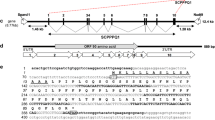Abstract
The developing enamel matrix is composed of two groups of proteins that can be generally classified as amelogenins and nonamelogenins. The hydrophobic amelogenins represent the majority of the developing enamel matrix proteins, whereas nonamelogenins include the more hydrophilic enamelins, proteinases, and other minor protein components, which represent a small proportion of the matrix. This report describes the purification and partial amino acid sequences of two previously unknown proteins isolated from developing bovine enamel. These proteins were prepared by extracting bovine secretory stage enamel with low ionic strength buffer, followed by ammonium sulfate fractionation. The proteins were purified by ion-exchange, affinity, and reversed-phase chromatography. We propose to designate the proteins BEgp (a glycoprotein) and BEpa. A partial sequence was also obtained from a third protein (BEpb) which was nearly identical to BEpa. Antibodies were prepared to a synthetic peptide based on the N-terminal sequence of BEpa and subsequent immunoblots of various bovine tissues showed a major component of ∼25 kDa specifically in enamel and ameloblasts. Little or no crossreactivity of the antibody was found to bovine proteins extracted from heart, lung, kidney, liver, dental pulp, or bone. Similar analyses of both rat secretory stage and maturation stage enamel showed two bands of 28 kDa and 29 kDa. Immunohistochemical localization in rat incisors showed specific staining of the enamel, secretory granules, and Golgi apparatus in ameloblasts. No sequence homology with known proteins could be demonstrated for BEgp or BEpa, suggesting that these components of developing enamel are novel tooth-specific proteins.
Similar content being viewed by others
References
Eastoe JE (1960) Organic matrix of tooth enamel. Nature 187:411–412
Eastoe JE (1963) The amino acid composition of proteins from the oral tissues II. The matrix proteins in dentine and enamel from developing human teeth. Arch Oral Biol 8:633–652
Eincham AG, Belcourt AB, Termine JD (1982) Changing patterns of enamel matrix proteins in the developing bovine tooth. Caries Res 16:64–71
Fincham AG, Belcourt AB, Termine JD, Butler WT, Cothran WC (1983) Amelogenins: sequence homologies in enamelmatrix proteins from three mammalian species. Biochem J 211:149–154
Termine JD, Belcourt AB, Christnes PJ, Conn KM, and Nylen MU (1980) Properties of dissociatively extracted fetal tooth matrix proteins: Principal molecular species in developing bovine enamel. J Biol Chem 255:9760–9768
Robinson C, Kirkham J, Hallsworth AA (1988) Volume distribution and concentration of protein, mineral and water in developing bovine enamel. Arch Oral Biol 33:159–162
Deakins M (1942) Changes in the ash, water, and organic content of pig enamel during calcification. J Dent Res 21:429–435
Robinson C, Fuchs P, Deutsch D, Weatherell JA (1978) Four chemically distinct stages in developing enamel from bovine incisor teeth. Caries Res 12:1–11
Deutsch D; Palmon A, Fisher LW, Kolodny N, Termine JD, Young MF (1991) Sequencing of bovine enamelin (tuftelin): a novel acidic enamel protein. J Biol Chem 266:16021–16028
Strawich E, Glimcher MJ (1990) Tooth enamelins identified mainly as serum proteins. Eur J Biochem 197:47–56
Fukae M, Tanabe T (1987) Nonamelogenin components of porcine enamel in the protein fraction free from the enamel crystals. Calcif Tissuc Int 40:286–293
Fukae M, Tanabe T, Uchida T, Yamakoshi Y, Shimizu M (1993) Enamelins in the newly formed bovine enamel. Calcif Tissue Int 53:257–261
Strawich E, Seyer J, Glimcher J (1993) Immuno-identification of two non-amelogenin proteins of developing bovine enamel isolated by affinity chromatography. Connect Tissue Res 29:163–169
Tanabe T, Fukae M, Uchida T, Shimizu M (1992) The localization and characterization of proteinases for the initial cleavage of porcine amelogenin. Calcif Tissue Int 51:213–217
Gasman M, Thommes P, Wieser T, Hubscher U (1990) Efficient production of chicken egg yolk anti-bodies against a conserved mammalian protein. FASEB J 4:2528–2532
Heussen C, Dowdle EB (1980) Electrophoretic analysis of plasminogen activators in polyacrylamide gels containing sodium dodecyl sulfate and copolymerized substrates. Anal Biochem 102:196–202
Smith CE, Nanci A (1989) A method for sampling the stages of amelogenesis on mandibular rat incisors using the molars as a references for dissection. Anat Rec 225:257–266
Nanci A, Ahluwalia JP, Zalzal S, Smith CE (1989) Cytochemical and biochemical characterization of glycoproteins in forming and maturing enamel of the rat incisor. J Histochem 37:1619–1633
Nanci A, Slavkin HC, Smith CE (1987) Application of highresolution immunocytochemistry to the study of the secretory, resorptive, and degradative functions of ameloblasts. Adv Dental Res 1:148–161
Overall CM, Limeback LM (1988) Identification and characterization of enamel proteinases isolated from developing enamel. Biochem J 256:965–972
DenBesten PK, Heffernan LM (1988) Separation by polyacrylamide gel electrophoresis of multiple proteases in rat and bovine enamel. Arch Oral Biol 36(6):399–404
Tanabe T, Aoba T, Moreno EC, Fukae M, Shimuzu M (1990) Properties of phosphorylated 32 kd nonamelogenin proteins isolated from porcine secretory ename. Calcif Tissue Int 46:205–215
Uchida T, Tanabe T, Fukae M, Shimizu M, Yamada M, Miyake K, Kobayashi S (1991) Immunochemical and immunohistochemical studies, using anti-sera against porcine 25 kDa amelogenin, 89 kDa enamelin and the 13–17 kDa nonamelogenins, on immature enamel of the pig and rat. Histochem J 96:129–138
Author information
Authors and Affiliations
Rights and permissions
About this article
Cite this article
Punzi, J.S., DenBesten, P.K. Purification of nonamelogenin proteins from bovine secretory enamel. Calcif Tissue Int 57, 379–384 (1995). https://doi.org/10.1007/BF00302074
Received:
Accepted:
Issue Date:
DOI: https://doi.org/10.1007/BF00302074




